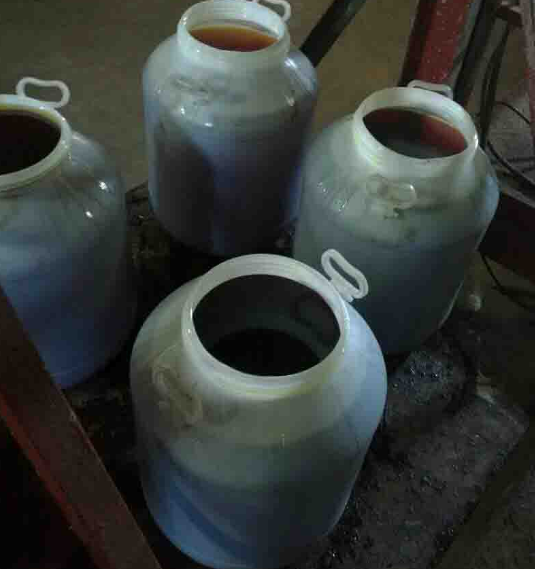Drilling Mud Emulsifiers
Drilling mud emulsifiers with organoclay also provide stable, well-balanced emulsions under difficult drilling circumstances. These emulsions manage drilling mud viscosity, reduce fluid loss, and prevent formations and gas pockets. Drilling fluid performance, borehole stability, and efficiency improve. These are also very adaptable to diverse drilling situations. Drilling mud emulsifier and organophilic clay can be optimized for onshore or offshore drilling, conventional or unconventional resources, and different formations.
Emulsifiers, Wetting Agents & Dispersants
Emulsifiers help produce and stabilize emulsions—mixtures of two immiscible liquids like oil and water. They reduce interfacial tension between liquids to generate a stable combination. Organoclay may be used alone or with other drilling mud emulsifiers to improve their performance. Organoclays are chemically altered clays that may be used with oils. In oil-based systems, organoclays increase emulsion stability and performance.
Wetting agents lower surface tension between a liquid and a solid surface, allowing the liquid to spread and adhere. Coating procedures and drilling mud mixtures need effective surface wetting. Dispersants prevent particles from aggregating or settling in liquids. They reduce particle attraction to keep particles suspended or distributed in liquid.
Primary And Secondary Emulsifiers
The CPMUL-P from Zhejiang Camp-Shinning works well as a main lubricant in oil-based mud systems. Its design makes sure that emulsification works well, that it stays stable at high temperatures, and that HTHP filtration is better controlled. Extensive testing has shown that it can keep its high electrical stability, low HTHP filtrate, and the right rheological qualities even when working at higher temperatures. CPMUL-P works well because of its parts, which include modified amidoamine, oxidized fatty acids, and a low-toxic organic liquid.
Zhejiang Camp-Shinning made CPMUL-S, which works as a secondary lubricant in oil-based mud systems. When used with the main emulsifier, CPMUL-S is successful at emulsifying, improves the heat stability of the reverse emulsion, and gives you more control over high-temperature, high-pressure (HTHP) filtration.
Comprehensive testing of different oil-based mud formulations with different base oils, mud densities, oil/water ratios, and hot-rolling temperatures has shown that the combination of CPMUL-P/CPMUL-S can maintain high electrical stability (ES), low HTHP filtrate, and the desired rheological properties at temperatures up to 149°C (300°F). CPMUL-S is made up of modified amidoamine, oxidized fatty acids, and an organic solvent that is not very dangerous.
Oil Based on Drilling fluid Oil base mud Primary emulsifier
Primary emulsifiers and organoclay stabilize oil-based drilling fluids. This combination are oil wetting agents and have great emulsion stability. Oil-based drilling fluids employ primary drilling mud emulsifiers and organoclays to reduce interfacial tension between the oil phase and the other liquid components. This emulsifier coats oil droplets to prevent coalescence and keep them distributed in the drilling fluid.
The primary emulsifier in oil-based drilling fluids also improves drilling lubrication by increasing the oil phase’s affinity for solid surfaces. Oil wetting is vital for effective drilling, wellbore stability, and equipment protection.
Primary emulsifier for oil-based drilling fluids
Primary emulsifiers when combined with organoclay or organophilic clay can stabilize oil-based drilling fluids. They help stabilize emulsions by lowering interfacial tension between the oil phase and other liquid components. Primary emulsifiers keep the oil phase in the drilling fluid, avoiding phase separation and improving drilling efficiency.
Organoclays are rheological additives that change the viscosity and thixotropic characteristics of drilling fluids, both water-based and oil-based. Organoclays are clay minerals treated with organic compounds to improve dispersibility and compatibility with hydrophobic or hydrophilic fluids. These additives influence drilling fluid flow and yield strength, enhancing hole stability and cutting removal.
In oil drilling muds, primary emulsifiers and organoclays have different functions. Organoclays improve drilling fluid rheology, whereas primary emulsifiers stabilize and disperse the oil phase. The choice of additives, including primary emulsifiers and organoclays, depends on the drilling operation, the formation being drilled, and the required drilling fluid parameters.
Emulsifier for Drilling Fluid
Drilling mud emulsifiers and organoclays are important additives that are used in a wide range of drilling uses, such as drilling fluid systems. They are very important for making sure that drilling fluids are stable, work well, and do their job.
Cement Additives
Cement additives like emulsifier and organoclay combination can improve slurries. These drilling mud emulsifiers improve cement slurries’ setting time, fluidity, and workability. Drilling mud emulsifiers in cement slurries optimize bonding and zonal isolation for particular well conditions.
Oil Base Mud Additives
Maintain emulsion stability and oil-based drilling fluid characteristics. Drilling mud emulsifiers with organoclay reduce oil-water interfacial tension to disperse solid particles and avoid phase separation. They improve drilling efficiency and wellbore integrity by stabilizing emulsions, resisting temperature, and controlling oil-based mud filtration and rheology.
Drilling mud system packages
Drilling mud system packages include drilling mud emulsifiers and organoclays are related to drilling fluids. Drilling mud emulsifiers that are mixed in with organoclays are an important part of these kits because they provide the stability, lubrication, and control over fluid qualities that are needed during drilling. These kits come with viscosifiers, filter control agents, and fluid loss additives, that can be used to adjust the drilling fluid system to the conditions of the well and the drilling goals.
Organophilic Lignites
Drilling fluid additives improve filtering and shale inhibition. Lignite, a low-rank coal, is chemically treated to make these additions organophilic or oil-wetting. Effective in limiting drilling fluid loss into the formation. These additives reduce fluid loss to stabilize drilling fluid, avoid formation damage, and optimize drilling.
Organophilic lignites interact with oil-based drilling fluids, improving compatibility and performance. These organophilic chemicals spread and adsorb onto shale surfaces, providing a protective coating that prevents drilling fluid water from entering the formation. This prevents wellbore instability and clay swelling. Rheological qualities improve drilling fluid performance. This thicken and viscosify drilling fluid to transport more drilled cuttings, clean holes better, and reduce the chance of blocked pipes.
Organophilic Gellants Chemicals For Oil-Based Drilling Mud
Organophilic gellants form a three-dimensional gel structure in drilling fluids. This gel structure enhances viscosity and gel strength, enabling the mud to suspend and convey drilled cuttings to the surface. It produces a filter cake on the wellbore walls, and it reduces fluid loss and formation invasion.
Organophilic gellants with drilling mud emulsifiers are oil compatible. They interact well with oil to generate a stable gel structure. These maintain gel strength and viscosity under high-temperature drilling settings. Organophilic gellants increase lubrication, temperature stability, wellbore stability, and cutting capacity. Oil-based drilling muds enhance these qualities with organophilic gellants.
Drilling mud emulsifiers
Wetting agents Additives For Oil-Based Drilling Mud
Oil-based drilling muds need wetting agents to promote fluid-formation interaction. These additives improve drilling mud wetting, providing improved wellbore wall and rock coverage. Oil-based drilling muds may make formation wetting difficult. The hydrophobic oil phase can’t moisten the rock formation’s hydrophilic surfaces, resulting in poor lubrication, higher friction, and worse drilling efficiency. Wetting agents reduce oil-formation interfacial tension to improve drilling fluid spreading and coverage.
Wetting agents in oil-based drilling muds reduce formation-fluid interfacial tension. Wetting agents reduce this tension to help drilling fluid flow over rock surfaces, lubricating and decreasing friction. This increases drilling efficiency and prevents trapped pipes. Wetting agents inhibit water invasion and emulsion instability in oil-based muds. They limit water penetration and preserve emulsion stability by oil-wetting rock surfaces. This is crucial in water-sensitive formations or situations where water incursion might harm wellbore stability or formations.
Polymeric viscosifiers | Drilling mud emulsifiers
Polymeric viscosifiers are important ingredients that are added to drilling fluids to make them thicker and improve their rheological qualities. These fillers are made of different polymers and are made to make the drilling mud better at carrying, suspending, and transporting cuttings.
Polymeric viscosifiers work by making long-chain structures in the drilling fluid, which makes it thicker. These long polymer chains get tangled up and interact with each other. This makes a three-dimensional network that makes it harder for the fluid to move. The resulting rise in viscosity helps to keep drilled pieces from sinking to the bottom of the wellbore by keeping them in suspension and moving them.
Rheological Modifiers Chemicals For Oil-Based Drilling Mud
Rheological modifiers are important chemicals that are used in oil-based drilling muds to control and change the way the drilling fluid flows and behaves. These additives are a key part of making the mud work better during digging operations by improving its viscosity, yield point, and shear-thinning properties.
For oil-based drilling muds to work well and keep the wellbore stable, they need to have certain rheological traits. Rheological modifiers are made to change how the drilling fluid flows to meet the needs of different drilling situations, such as when the temperature, pressure, and features of the rock change.
Organophilic clay is a type of rheological stabilizer that is often used in drilling muds that are made from oil. Organophilic clay additions are changed clays that can be mixed into the oil phase of the drilling fluid to make a stable gel-like structure. These additives improve the mud’s stickiness and yield point, which makes it easier to suspend and move drilled pieces.
Drilling mud emulsifiers | Weighting Agents
Weighting agents are important additives that are put into drilling fluids to make them heavier. These agents are meant to make the drilling fluid heavier so that it can put enough pressure on the walls of the wellbore and control rock pressures while digging.
It is important to keep the drilling fluid at the right density to avoid problems with well control like kicks or blowouts and to keep the wellbore stable. Weighting agents help get the right density by making the drilling fluid heavier without changing its other features too much.
Drilling mud emulsifiers
Welcome to consult our Drilling mud emulsifiers and learn more about its price and product description.


